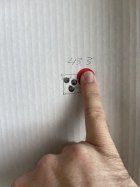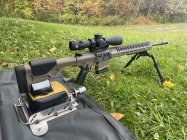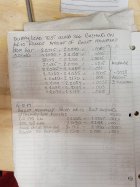First i want to say thank you.The only way I can see the bullet moving forward to due to the abrupt change in velocity when the round is chambered. The bullet shifting forward can only happen if there is a force on the bullet in the direction of motion. A rapid change in velocity of the brass the friction between the neck of the brass and bullet may not be able to apply a large enough force on the bullet to keep it from sliding forward in the casing.
To visualize what I am talking about think about inertial bullet pullers, the bullet comes out because the motion is abruptly changed. The heavier piece in the puzzle does not have a large enough force (the friction between the neck and the bullet) on it to keep it in the casing.
I have done enough physics and shooting/gunsmithing on ARs that I believe I have described the only mechanism that will cause the bullet to shift forward in the case, assuming that it is not a heavily compressed load. With that in mind there are a number of ways this can/may be remedied.
Either the force between the bullet and the casing needs to be increased with increase friction between case neck and bullet, by one or more of the following:
Alternatively or in combination, reducing the forward velocity of the bolt carrier group (BCG) which you might be able to achieve by a heavier BCG, heavier buffer, and/or lighter spring. The forward velocity of the BCG is strictly a function of the spring strength (variable), distance spring is compressed (fixed) and the total weight of the buffer and BCG (variable). These changes are just trying to keep the bolt from slamming forward too hard.
- By reducing carbon on interior of case necks carbon acts to reduce friction,
- reducing the neck diameter further when sizing by reducing ID of bushing (assuming you are using bushing dies) or
- mechanical interference via crimping.
I find that a lot of AR=10's are over gassed and they can be helped by a heavier buffer so this is something you might try as it is sometimes easier on the brass. Too heavy is not good as it can mess with timing like all else there is a happy medium and sometimes it can actually be found. Operating too violently and an adjustable gas block is a good idea to throttle down impulse at the beginning of the process.
Newton is whispering in my ear (a mental malady of many people with too much physics work) and says try a lighter bullet as it will require less force to keep it in position in the case. Unfortunately, the lighter bullet may not do what you want to do.
Hope this helps,
wade
I’m using brand new Lapua brass. I do have adjustable gas block and i will adjust that as you mentioned in your post. I will shoot for accuracy and ES with .003 tension and see how it performs. If results are shit i will increase neck tension. If that is not working i will adjust gas block. If that is not working i will focus on BCG and spring system. But i will do one change at the time and test and i will update here info i get.
Im just amazed how much help im getting from you guys and i want to say thank you. I do have family and lil baby so it will take me lil bit i need time. But i will keep you updated as i test I will update results here.













